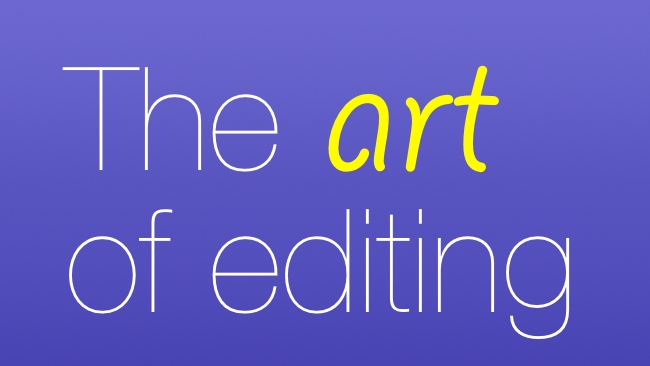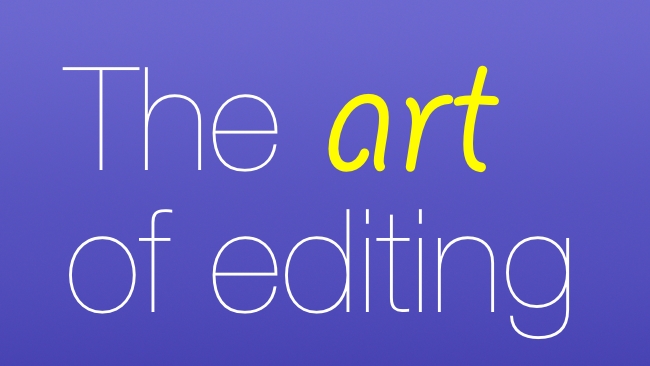
 The art of editing
The art of editing
RedShark Replay: With interest in all things editing at a high on the RedShark site, here's another chance to read Peter Hass' excellent article on the art of editing.
An extremely important part of my editing process is note-taking. This is particularly true on larger films or projects that span long periods of time. I find that writing down my thoughts and concepts is the only way I can keep all that information and ideas straight. Recently while working on the opening reel for a new documentary I found myself stuck. After trying multiple approaches I felt as though I was still spinning wheels. I decided to look back through my notes from other projects to see if I could spark a creative fire.
I came across old notes I had made that helped me get a new start on things. These points are a combination of original thoughts and are probably casually inspired by conversations I was having with editor friends at the time.
Be up front
A very important lesson I've learned over the years is to put your thesis and visual concepts upfront. The screen is a sort of keyhole that the audience is peeping blindly through into the lives of your characters and story. When you're putting your film together, you need to place yourself on the opposite side of that door and hang out in your audience's mental space. By putting the important factors of your story up front you are setting up the context for the rest of the film.
The first few scenes of your film are very important: you are expressing what part of the filmic language you are using; what cinematic "dialect" the film will be speaking in. I like to think of the first real as a Rosetta Stone for the rest of your film.
Now I'm not saying that every film needs to have an opening title crawl or voice-of-god narration to describe who everyone is and what is going on, but the opening scene (or the entire first reel) says a lot about your film and how you plan on communicating with your audience.
Plot, theme and "what this is about" are different
Alan Moore, a graphic novel/comic book writer most famous for Watchmen and V For Vendetta, wrote an essay on his process of creating comics. Part of his advice to aspiring writers revolved around the fact that many people (including himself in his early years) would all too often confuse what the story was about with the plot and themes.
Moore discusses at length his theory on the differences, but to sum it up, the plot of the story is simply all the moments that are occurring (the action), while what a story is about tends to be played out through the action of the story.
My own example of this would be, say something like Stanley Kubrick's version of The Shining. (Caution: spoilers.) The plot is pretty straight forward: a family stays the winter at an isolated hotel, until the father, Jack, starts developing a possibly supernatural case of cabin fever and begins tormenting his family until he becomes trapped in the frozen maze outside the hotel. The themes that are revealed through that plot are lot more complicated than a simple "slasher" horror film; issues of alcoholism, family disfunction, and family violence are deeply ingrained in much of the story (as is a lot more according to the documentary Room 237). The film seems to be about inner demons coming to the surface and harm that causes other and one's self.
I strongly suggest you find a copy of "Writing For Comics, Vol. 1*" by Alan Moore as a many of the visual and narrative concepts hold true with cinema as well as comics.
(*note, there are no other sequels / volumes. I assume it was a joke by the author).
Be flexible
How does that old saying go? "Best laid plans of mice and men directors and their AD's." Planning is crucial to the success of any film. This means in the cutting room or out in the field. But being overly rigid in the face of adversity will only result in compounding problems and failure. If the dolly shot isn't working or the montage isn't telling the right story, it's important to have a clear vision of what you're attempting to say, have the ability to step back, and willpower to change your approach.
Have people you trust at hand
One of the best tools you can have in completing a film is a test audience. Before you bring your film out to the public, it's a good idea to have more private feedback. Typically this is going to be your story producer or the director, but in most instances they've been working as long as you have on the film, are going to be just as close to the story as you, and are likely to be blind to a number of the same issues. It's always good to have a friend or two that knows the business and is willing to give honest feedback about their experience watching the film.
It's important to make sure that this friend isn't going to be a "yes"-man; you're not looking for someone to blindly tell you that your efforts are valiant and that your film is the best thing since Citizen Kane. You need someone who can point out what's working and what isn't, and in the best case scenario, offer some clues as to how you can communicate, visually or otherwise, what is missing from your current edit.
Having someone who works professionally in the film industry to give you feedback is very helpful, but anybody with a healthy sense of reflection and cinematic knowledge can be helpful. Just make sure that you choose people whom you trust to give feedback (even negative feedback) in a fitting manner. Positive notes can help move a film in the right direction just as quickly as poorly constructed feedback can derail you. Besides, filmmaking is an incredibly lonely and difficult process, it's nice to introduce outside company once and a while. Doing it all in a vacuum will not only damage your film but is a sure way to land yourself in the nut house. Trust me on this one.
Golden rule of editing
If it were possible to boil everything down to a single slogan or rule, it would be something that my Thesis Advisor always told me when I was heading into the cutting room: "Stop thinking about it, if the damn cut works, it works." This sounds like very common sense, but all too often when you find yourself in the weeds it can be very refreshing advice. My friend and often co-filmmaker Keif Roberts equally reminds me to avoid "paralysis through over analysis," or "don't over think it!" which I find to echo this mentality.
Whether you agree or disagree, I think that this sums up a good portion of my editing philosophy at the moment, and I believe they equally relate to both narrative and documentary.
These tips are intentionally broad, and are meant to act as more of a background process in your mind when you're visiting your film's material. A little kindle to your creative fire.
What's been going through your mind while you've been editing your stuff? Share your thoughts and experiences in the comments section!
Tags: Post & VFX



Comments